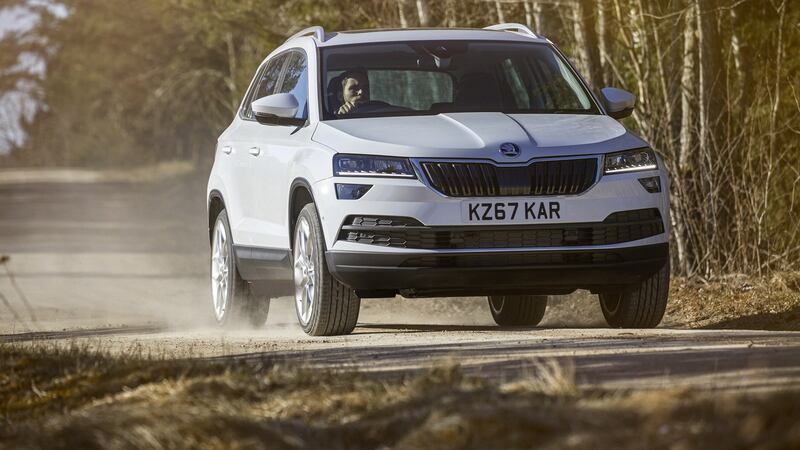It might have been a late arrival to the SUV party, but Skoda can't keep up with the demand for its recent crossover, the Kodiaq. Brand director of Skoda Ireland, John Donegan, recently told us of the challenge dealers had in managing their order books for the crossover, something we haven't heard about since the heady days of the Celtic Tiger. In some instances buyers can wait several weeks before taking possession of their shiny new pride and joy.
The arrival of the Karoq, therefore, may help to alleviate some of this demand. The smaller Skoda aims to take on the likes of the Hyundai Tucson – Ireland's best-selling car – and the Nissan Qashqai. Within the VW Group it goes up against the Volkswagen Tiguan and the recently launched Seat Ateca.
The Karoq shares its underpinnings with the Tiguan and Ateca, the group’s award-winning MQB platform. And as such, it drives like every other VW Group vehicle: predictable, dependable and arguably a little dull.

It’s not something that will unduly worry potential buyers, nor the engineering experts within the group. This is merely a reflection of the success of the group’s work: the end results have a solid, relatively sophisticated performance. When it comes to function, few can question the Skoda’s ability.
The Karoq is extremely functional. As a five seater there is ample room in the back for those over six feet tall, while it retains a boot that will cater for virtually all family needs, offering up 521 litres with the rear seats up and a whopping 1,630 litres with them folded down. What’s more, you can remove the rear seats entirely to make even more space if needed, bringing the total space to a van-like 1,810 litres.
Digital panel
Up front it continues the Skoda format, taking its layout from all the other new Skoda's on the market, with the exception of the option of a digital instrument panel – Skoda's answer to the Audi virtual cockpit. However, until we see a price for this option, it's hard to say whether it's worth adding or not.
From its functional, square styling on the outside to the practical interior, the Karoq underlines its family credentials. The issue is that it all lacks a little character. Perhaps this is an issue only because this new model replaces the Yeti, a car that in its early iterations had a certain charm that's often missing in the family car segment. Just because a motorist finds themselves burdened with the duties of family life, it shouldn't mean that fun and a little frivolity are forbidden from their motoring life. Cars like the Fiat Multipla at the extreme, or the early Yetis may have seemed like oddities, but they stood out from the crowd. Too many crossovers are standard issue formats that could just as easily have emerged courtesy of a computer algorithm as a human designer's efforts.
Engine options
The engine line-up includes a 1.0-litre TSI 3 cylinder petrol (113bhp), a 1.5-litre 150bhp petrol and a choice of diesels, in both 1.6-litre TDI (113bhp), a 2-litre TDI (148bhp and 186bhp) guise. The Karoq also comes in either two or four-wheel-drive.
Given the growth in petrol sales and the fact that many low-mileage suburban family buyers will consider returning to this format, we tested the 1.5-litre petrol and the 2-litre diesel, both putting out 150bhp. Of the two, the petrol was the smoothest and the more refined, if you can reset your brain to accepting the idea of owning a petrol crossover.
On the road, the Karoq always feels solid and surefooted, with plenty of feedback through the steering to inspire confidence in the corners. On tricky rain-sodden back roads in northern Denmark, and with muddy tracks left by tractor tyres every 500m adding to the mix, the Karoq was impressively composed. The MQB platform has received a host of accolades and understandably so. Hoisting it up to crossover height hasn't called into question its ability and the more you drive it the more you discover its impressive agility.
Of course it claims to have some off-road credentials, in line with its SUV styling and its 183mm ground clearance. Its “off-road” driving mode actually changes the parameters of the various driver aids, such as Hill Descent Control, to improve the car’s ability on loose terrain.
Price remains the great unknown but we are hoping for some clarity on this in the coming weeks. If it sticks closely to rivals like the Hyundai Tucson (starting below €30,000) then it should be a major seller for 2018.
Given the high esteem in which Skoda is held among Irish drivers, and the impressive demand for the Kodiaq to date, so long as Skoda Ireland gets the price right the Karoq could well be a challenger for the best-selling title.
Irish buyers have shown that they love this format and size of car and the Karoq delivers everything that’s asked for in cars in this category. Personally I think it could have retained some of the Yeti’s charm and distinction but there’s no question you will see a lot of Karoqs on the road by the middle of next year. And their owners should, all things considered, be very content.




















